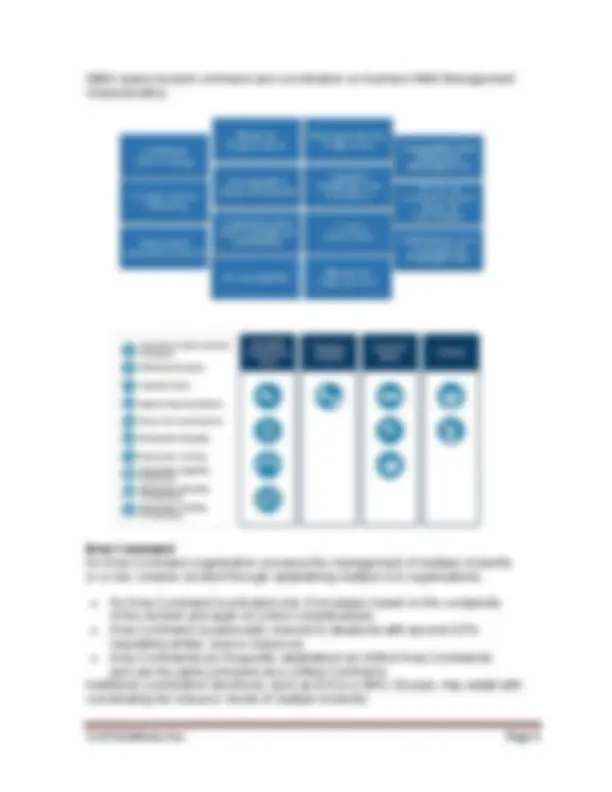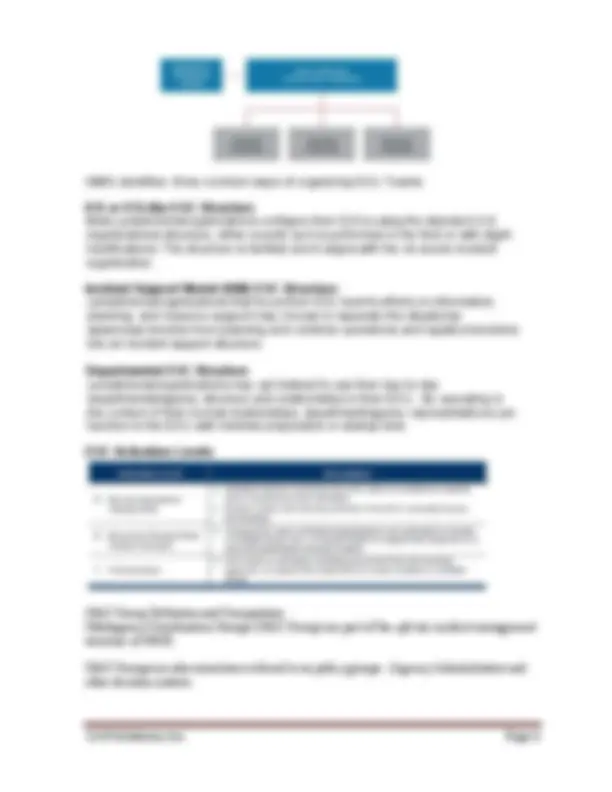






Study with the several resources on Docsity

Earn points by helping other students or get them with a premium plan


Prepare for your exams
Study with the several resources on Docsity

Earn points to download
Earn points by helping other students or get them with a premium plan
Community
Ask the community for help and clear up your study doubts
Discover the best universities in your country according to Docsity users
Free resources
Download our free guides on studying techniques, anxiety management strategies, and thesis advice from Docsity tutors
modifications. The structure is familiar and it aligns with the on-scene incident organization. Incident Support Model (ISM) EOC Structure.
Typology: Study notes
1 / 8

This page cannot be seen from the preview
Don't miss anything!





NIMS Guiding Principles NIMS provides these stakeholders across the whole community with the shared vocabulary, systems, and processes to successfully deliver the capabilities described in the National Preparedness System. Priorities for incident management include saving lives, stabilizing the incident, and protecting property and the environment. To achieve these priorities, incident management personnel use NIMS components in accordance with three NIMS guiding principles:
NIMS Framework - Major Components Resource Management Resource Management describes standard mechanisms to systematically manage resources, including personnel, equipment, supplies, teams, and facilities, both before and during incidents in order to allow organizations to more effectively share resources when needed. Command and Coordination Command and Coordination describes leadership roles, processes, and recommended organizational structures for incident management at the operational and incident support levels and explains how these structures interact to manage incidents effectively and efficiently. Communications and Information Management Communications and Information Management describes systems and methods that help to ensure that incident personnel and other decision makers have the means and information they need to make and communicate decisions.
NIMS Is NIMS Is Not A comprehensive, nationwide, systematic approach to incident management, including the command and coordination of incidents, resource management, and information management
Only the Incident Command System Only applicable to certain emergency/incident response personnel A static system A set of concepts and principles for all threats, hazards, and events across all mission areas (Prevention, Protection, Mitigation, Response, Recovery)
A response plan
Scalable, flexible, and adaptable; used for all incidents, from day-to-day to large-scale
Used only during large-scale incidents Standard resource management procedures that enable coordination among different jurisdictions or organizations
A resource ordering system
Essential principles for communications and information management
A communications plan
Resource Management Key Activities Overview Resource management preparedness involves four key activities:
Identifying and typing resources Qualifying, certifying, and credentialing personnel Planning for resources Acquiring, storing, and inventorying resources Qualifying, Certifying and Credentialing Personnel The Authority Having Jurisdiction (AHJ) has the authority and responsibility for qualification, certification, and credentialing within its organization or jurisdiction.
The establishment of national standards provides common, compatible structures for the qualification and certification of emergency management personnel.
Qualification, certification, and credentialing are the essential steps to help ensure that personnel deploying under mutual aid agreements can perform their assigned roles.
Qualifying: Personnel meet the minimum established standards (including training, experience, physical and medical fitness) to fill specific positions. Certification: recognition from an Authority Having Jurisdiction (AHJ) or a third party that an individual has completed qualification for a position (one example of a third party is an accredited body such as a state licensure board for medical professionals). Credentialing : documentation – typically an identification card or badge – that identifies personnel and verifies their qualifications for a particular position.
NIMS identifies three common ways of organizing EOC Teams:
ICS or ICS-like EOC Structure Many jurisdictions/organizations configure their EOCs using the standard ICS organizational structure, either exactly as it is performed in the field or with slight modifications. The structure is familiar and it aligns with the on-scene incident organization.
Incident Support Model (ISM) EOC Structure Jurisdictions/organizations that focus their EOC team's efforts on information, planning, and resource support may choose to separate the situational awareness function from planning and combine operations and logistics functions into an incident support structure.
Departmental EOC Structure Jurisdictions/organizations may opt instead to use their day-to-day departmental/agency structure and relationships in their EOC. By operating in the context of their normal relationships, department/agency representatives can function in the EOC with minimal preparation or startup time.
EOC Activation Levels
MAC Group Definition and Composition Multiagency Coordination Groups (MAC Group) are part of the off-site incident management structure of NIMS.
MAC Groups are also sometimes referred to as policy groups. (Agency Administrators and other decision makers.
MAC Group members are typically agency administrators, executives or their designees from stakeholder agencies or organizations impacted by and with resources committed to the incident. The MAC Group may also include representatives from non-governmental organizations such as businesses and volunteer organizations.
When an incident occurs or threatens, local emergency personnel manage response using NIMS principles and ICS. If the incident is or becomes large or complex, local EOCs activate. EOCs receive senior level guidance from MAC Groups.
A Joint Information Center (JIC) manages the Joint Information System (JIS) operations to ensure coordinated and accurate public messaging among all levels: ICS, EOC and MAC Group. If required resources are not available locally, they can be obtained under mutual aid agreements from neighboring jurisdictions, or State, tribal, territorial, and interstate sources (EMAC) Emergency Management Assistance Compact, and assigned to the control of the Incident Commander or Unified Command
Federal Support to Response Activities The Federal Government has a variety of capabilities and resources to support domestic incidents.
Most incidents are resolved using capabilities available from the local jurisdiction.
Larger incidents are resolved with support from by neighboring jurisdictions, or State, tribal, territorial, and interstate sources.
The Federal Government only becomes involved with a response:
In most cases the Federal Government plays a supporting role to state, tribal, or territorial governments by providing Federal assistance to the affected jurisdictions.
National Incident Management System; Operational Period Planning Cycle: Initial Response Objectives:
Content:
Graphics: (optional)
Students will be ableto describe the stepsand purpose of theInitial Response, or“leg” of the Planning“P.”
The Initial Response The leg of the “P” describes six steps in theinitial stages of an incident. The initialstages are meant to gain awareness of thesituation and establish the organization forincident management.The initial response is essential tosituational awareness and it enables theIncident Commander to request additionalresources and/or support, develop, andimplement initial tactics. Incident Management Incident personnel perform the steps in theleg of the “P” only one time. Once thesesteps are accomplished, incidentmanagement shifts to the top of the “P,”and begins a cycle of planning andoperations. Initial Response Steps:
Incident
Notification
Initial Response and Assessment
Agency Administrator Briefing (ifappropriate)
Incident Briefing
Initial UC Meeting
Alternative Text for Planning “P” graphic: The graphic depicts the Planning “P” chart. The Planning “P” process begins with the initial response and the information gatheringand sharing. The steps in these processes are incident/threat, notification, initial response and assessment, agency administratorbriefing (if appropriate), incident briefing ICS 201, initial UC meeting (if Unified Command), IC/UC sets initial incident objectives, andinitial strategy meeting and information sharing. After this initial step the process moved to being a cycle of tactics meeting,preparing for planning meeting, planning meeting, IAP preparation and approval, operational period briefing, begin operationalperiod, execute plan and assess progress, IC/UC validate or adjust objectives, strategy meeting if objectives adjusted, and then backto tactics meeting to begin the cycle over again. Information gathering and sharing is happening continuously throughout thisprocess.